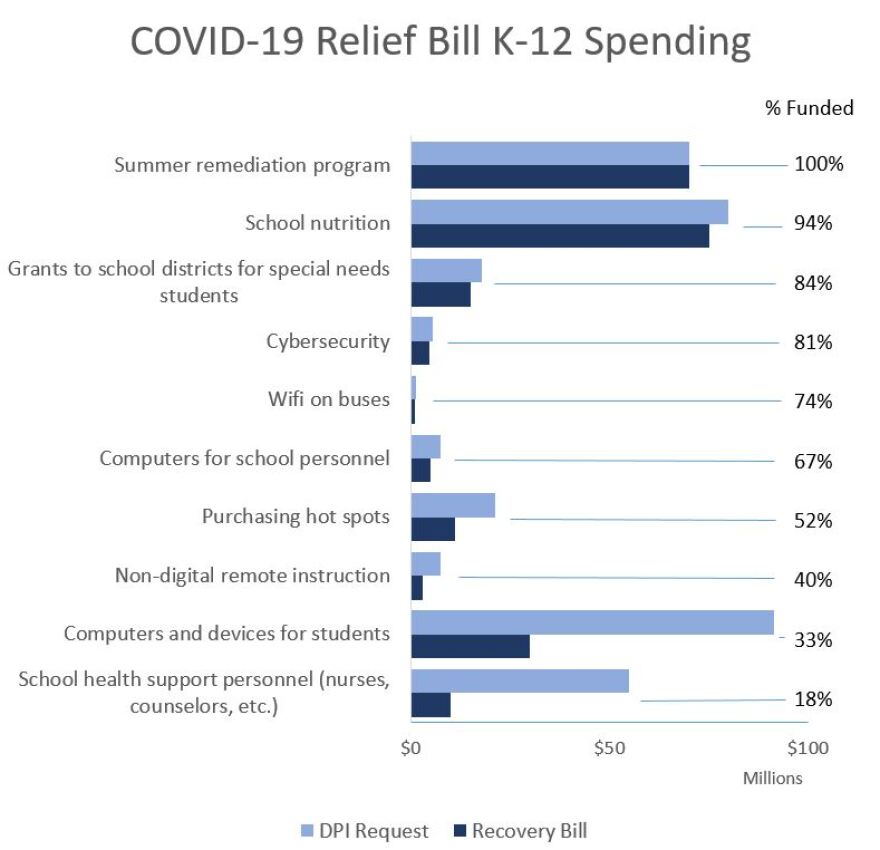The pair of COVID-19 recovery bills passed by the North Carolina General Assembly and signed into law by Governor Roy Cooper provide broad relief and numerous funding streams dedicated to K-12 public school students.
Those individual line items - paid for with federal aid - cover a cornucopia of students' needs.
"Today's bills provide for feeding schoolchildren, summer learning programs to help them catch up and funding to purchase computers for students who need them," Cooper said at a press conference.
The funding bill allocates federal dollars for cybersecurity; school counselors and nurses who support students' well-being; and wifi hotspots on buses that may simultaneously deliver students their lunches, homework and new Chromebooks.
But collectively, all of those pots of money in this first round of funding add up to less than two-thirds of what state education officials requested on behalf of the students they represent.
The Gap Between What Education Officials Wanted, And What They Got
Here's a breakdown of what the Department of Public Instruction requested in federal aid, compared to what the state government has allocated so far:

The greatest discrepancy, in real dollars, between what education officials requested and what the aid package provides is in funding to buy students computers. The Department of Public Instruction conducted a survey of school districts and charter schools and concluded that about 300,000 North Carolina students lack the basic tools to connect to digital learning.
The deepest divide, according to the percentage of the Department's request funded, is for school health personnel, which some professional associations have long pointed to as under-funded.
Competing Needs
House speaker Tim Moore noted at the bill signing that there is more federal aid to spend, but also more necessities to come. The state government is projected to lose up to $4 billion in tax revenue due to the pandemic.
"Going into next year's budget, when schools open back up, when things are running ... we have to pay for all those things," Moore said.
Mark Jewell is the President of the North Carolina Association of Educators, a lobbying group representing public school employees. He called the new law "a great first step."
"The needs are so great right now," Jewell said. "It's going to take a lot more to meet the needs of our kids during the pandemic."
Jewell said the National Education Association will continue to lobby Congress to provide more federal aid to students. He also said the Association's top priority is for school personnel to keep their jobs through the expected state budget shortfall.
New Measures For A New School Year
The House's recovery bill assigns dollar amounts to federal aid received via the CARES Act. Its companion, Senate Bill 704, provides legislative relief in the form of temporary exemptions from various state laws.
Among those exemptions are waivers of testing requirements and school accountability measures for the 2019-2020 school year, that would typically have consequences for incentives and interventions in the following academic year.
The law adjusts the coming school year to begin classes a week earlier than usual in August. Governor Cooper recently announced that he expects public schools to reopen to students in the fall; even so, the Senate bill requires schools to craft plans to sustain remote learning next school year.
The House proposed a waiver to delay an on-going reduction in elementary school class sizes, which critics have long called an unfunded mandate. Ultimately, it was not included in this recovery package. Class sizes may become a greater concern when schools prepare to reopen and ward off contagion.
The state legislature still has about two billion dollars in federal funding to allocate, and will meet again in mid-May to continue debate on how to spend federal aid.









